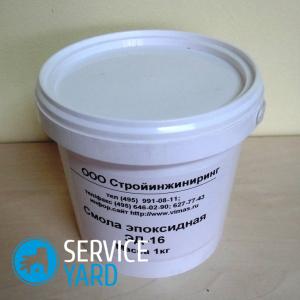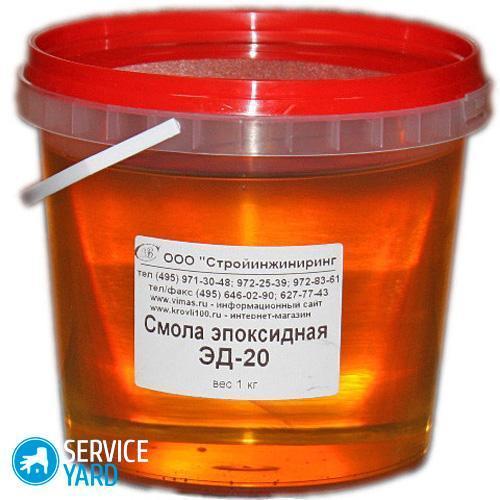How to dissolve epoxy resin?

Surely those who at least once used for any purpose an epoxy resin or glue based on such a substance, faced with such a difficult task as dissolving during work or cleaning after completion of assembly of the desired design. If you are also puzzled by the question of how to dissolve epoxy, this article is for you.
to contents ↑What you need to know about epoxy
Before looking for a solvent for epoxy resin, one must understand its composition and features. They are as follows:
- Such adhesive solutions are based on 2 components. Under special conditions - the addition of plasticizer, as well as heat treatment, they enter into the reaction. It is because of this that polymerization occurs.
- A special demand for such compositions is that in the hardened form the glue is very hard, resistant to mechanical stress and moisture, and it does not lose its special characteristics for a greater amount of time.
to contents ↑Important! This substance is used not only for gluing, but also in order to impregnate wood, glass and fiberglass with it. This is done in order to improve their physico-chemical properties and reduce the chance of destruction.
How to choose the right method?
Since the application technique involves pre-heating the substance, as well as applying it in the form of a liquid to the surface you need, it is unlikely that you can do this very clearly and accurately along the border.
Despite its excellent characteristics, it is still possible to dissolve the epoxy resin, and several products are suitable for this.
to contents ↑Important! The basic principle for removing such a substance is to start the reverse process, and this procedure can cause damage to the main surface. Therefore, before you choose a tool, specify whether it can be used with the main surface, preventing its destruction.
How to remove epoxy resin?
In order to dissolve the epoxy resin, several methods are used:
Scraping with a sharp object
This method is suitable only for that surface on which a similar process with direct mechanical action will not be affected by any damage.
Important! For metal, this option is strictly contraindicated, as well as painted surfaces. In this case, there is a high probability of the formation of scratches and chips, which will subsequently corrode.
Cured resin heating
This method implies the presence of certain skills in working with construction equipment and requires maximum accuracy.
Important! An excellent solution would be such a treatment of wooden as well as unpainted plastic surfaces. They will painlessly tolerate such an effect.
To dissolve the epoxy resin, proceed as follows:
- Using a degreaser that does not contain alcohol, clean the surface.
- Then heat the resin with a building hairdryer until it becomes viscous and fluid.
- Once you have reached the desired consistency of the adhesive mass, remove it with a knife or another suitable object.
- Now you just have to wipe the remaining small elements of the resin with a cotton pad moistened with the right tool. An epoxy solvent such as acetone is perfect here.
Important! During this procedure, do not forget to protect the face, hands, body, so as not to award yourself burns.
Solvent dilution
Epoxy is a component of many adhesives. It is a viscous and flowing liquid, and it is this property that makes its use not always convenient. The small viscosity of the resin ensures its fluidity, therefore, using a brush or a roller, it is very easy to apply to fiberglass. Porous surfaces are also easily impregnated with it.
Dissolution is performed most often with the aim of reducing the viscosity of the solution used.
Important! Note that dilution of epoxy affects significantly the characteristics of the final polymer - the strength and water resistance of the surface is significantly reduced.
Most solvents are suitable for diluting such a material, but are usually used:
- thinner for varnishes;
- acetone;
- denatured alcohol.
to contents ↑Important! The volatility of these substances allows them to evaporate very quickly, and not to linger in the resin.
The basic rules for dissolving epoxy:
- Even a very small amount of solvent significantly reduces the viscosity of the solution used.
- Adding a solvent reduces the strength of the hardened polymer, and this is precisely what prevents it from being used during the manufacture of structural products.
- The epoxy solvent significantly increases the curing time of the polymer mass.
- Diluents cause the resin to shrink. It happens that not all solvent has time to evaporate from the adhesive mass, and that is why it continues to disappear during the polymerization, as well as after it. This may cause microcracks in the frozen surface.
- Sometimes solvents affect the color of the polymer you work with.
- The presence of solvent in the solution or adhesive may damage the surface.
Stock footage
We hope that our methods and recommendations will help you cope with the epoxy resin and you will be able to maintain its strength characteristics after dilution, without spoiling the items to be glued.
- How to choose a vacuum cleaner taking into account the characteristics of the house and coatings?
- What to look for when choosing a water delivery
- How to quickly create comfort at home - tips for housewives
- How to choose the perfect TV - useful tips
- What to look for when choosing blinds
- What should be running shoes?
- What useful things can you buy in a hardware store
- Iphone 11 pro max review
- Than iPhone is better than Android smartphones




